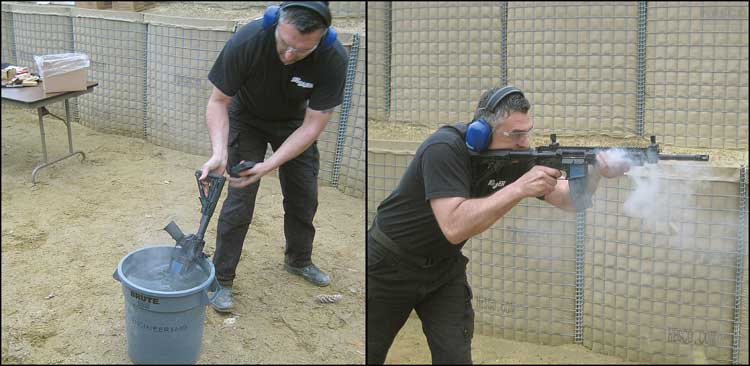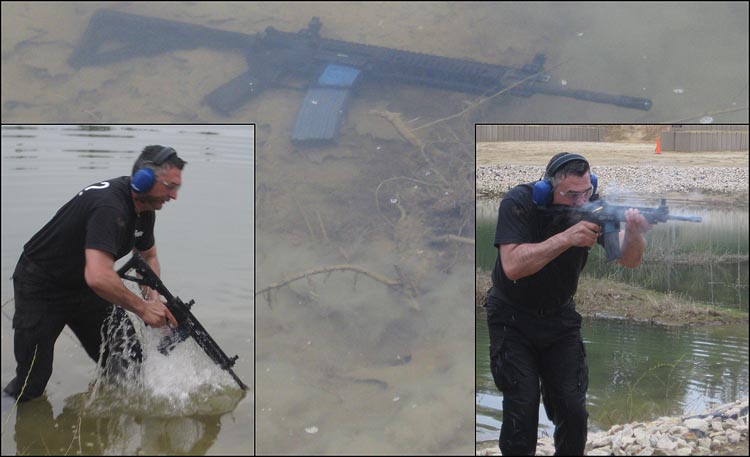The SIG Sauer 516 Patrol is one of the latest gas-piston ARs introduced into the U.S. market. Do not confuse the SIG 516 with the SIG 556 derived from the legendary SIG 550 line of assault rifles. Designed to accept AR-15/M16 magazines with rear stock interchangeable with AR-15 designs, the SIG 556’s operating method is closer to the Kalashnikov’s gas-piston operating rod system. There have been references to the SIG 550 operating rod system being described as the Porsche of AK designs due to the tighter tolerances and better workmanship found in SIG Sauer weapons compared to other manufacturers using the AK as a basis of design. The operating rod system keeps the action cleaner, cooler, and overall more reliable. A previous article in SAR (November 2009) covered the SIG 556 in more detail. These positive attributes are what the SIG 516 piston AR seeks to capture while maintaining the popular and well known AR design basis; typified by bolt carrier group, buffer tube, and accessory compatibility that many individual and law enforcement agencies are intimately familiar with. Typical of the Swiss/German engineering background of the company, the design was not hastily introduced. Considering the recent rush by many manufacturers to create gas-piston ARs, SIG decided to enter the fray only after thoroughly exploring the topic and by designing their own short-stroke push rod piston driven system for the AR.

Numerous standard features found in the SIG 516 product line will pleasantly surprise consumers. The SIG 516 seeks to maximize the 50-year old AR design in terms of reliability and operating efficiency. SIG Sauer CEO Ron Cohen, who has been at the company helm for five years, stresses a corporate culture blending U.S. drive/marketing with Swiss/German engineering. This new culture is evident in SIG bowing to U.S. market demands by creating a SIG variant AR-15. The SIG 516 foregoes the previously held European centric attitude of, “if it is not designed here it is not worth it.” The SIG 516 is the AR-15 with SIG refinement typified by self cleaning short stroke/push rod operating system and other features. The SIG twist on the AR design consists of a 3-position gas valve (4-position valve optional), proprietary barrel nut locking system, free-floated aluminum M1913 quad rail system that is “dog boned” at receiver/forend to prevent twisting and provide an uninterrupted top rail, bolt carrier group with integral strike plate and anti-tilt radial grooves, ambidextrous fire control selector, multiple built-in quick detach sling swivel attachment points, and front sight base attached to gas block keeping it independent of quad rail influences to mention a few features.

The SIG 516 AR-style rifle will be offered in numerous configurations. These include LE/military only select-fire versions, various barrel lengths/profiles ranging from 7 inch PDW model to 20 inch Precision Sniper, and several styles of rear stock. SIG 516 barrels are chambered in 5.56x45mm and chrome-lined hammer forged featuring 1:7 RH twist with Nitride finish. The muzzle is threaded 1/2″x28 pattern for flash hiders or other types of muzzle devices. Currently the SIG 516 Patrol is equipped with an A2 style flash hider. Both the lower and upper receivers are machined from 7075-T6 aircraft grade aluminum forgings coated in black anodized finish. The short-stroke push rod operating system with adjustable gas valve is the heart of the SIG 516 setting it apart from other AR designs.

The SIG 516 Patrol is the first model available for wide distribution and weighs 7.3 pounds and has an overall length of 39.5 inches and 36 inches with stock collapsed. It is equipped with a chrome lined M4 contoured style 16 inch barrel surrounded by a four sided aluminum Picatinny rail and A3 style upper receiver. Traditional AR-15 style forward assist plunger button and dust covers are included along with checkering on the magazine well for a more positive grip. The magazine well is chamfered and the raised rails around the magazine release button are pronounced for more positive tactile feedback during weapon manipulation.
An invitation to the SIG Sauer facility in New Hampshire allowed a unique opportunity to review SIG 516 features. Designers and program managers present answered any questions about features along with providing the thought process behind design tweaks. SIG believes they were successful at bringing out the best of the AR design. A SIG 516 Patrol was fired extensively during an open range session where participants got the opportunity to handle the SIG 516 Patrol for themselves. A conservative estimate is at least 1,200 rounds were fired from each of the two SIG 516s made available for hands on evaluation. The rifle was hardly put down during the range time. No function problems were encountered with either of the rifles. One of the rifles was equipped with a Leupold Mk 4 3.5-10x for accuracy demonstration purposes. The SIG 516 proved capable of 1.5 inch groups at 100 yards with Hornady 60 gr TAP ammunition. Most of the shooting was done with military grade 5.56mm 55gr and 62gr FMJ ammunition. The other SIG 516 was equipped with a SIG Sauer STS 081 red dot optic. It proved more than capable of ringing the various steel targets placed 100-150 yards down range with regularity. The SIG 516 handled as expected from an AR-15 style rifle – quick to the shoulder and with great ergonomics. A point was made to remove the bolt carrier group during the range session to demonstrate gas piston benefit in terms of being much cooler and cleaner compared to a typical gas impingement operated AR. Readers are all too familiar with the basic AR platform to go into minute detail about handling characteristics.

The SIG 516 Patrol has several standard items incorporated in its design for better performance that show SIG’s attention to detail. An enlarged steel barrel nut is utilized in the assembly method of the SIG 516. The steel barrel nut acts as a heat sink to further reduce temperature build-up in the action area as the rifle heats from use. This combined with their proprietary free floated rail design that is “dog boned” together at the receiver ensures accuracy will not be negatively affected by heat from extensive firing or “torque” applied from vertical forward grips or other accessories. A further enhancement in this regard is the front sight placement on the gas block versus the free floated rail minimizing sights being impacted by heat or other factors associated with handrail shifting. Their gas-piston system has three adjustment positions with four settings available as an option. The four positions are standard, adverse, suppressor, and single shot. The gas valve is adjustable via 5.56mm bullet tip, thus if you have ammunition, you have a tool to adjust the gas system. The short-stroke push-rod gas system serves to isolate the action from heat and fouling, especially when compared to the typical AR direct gas impingement method of dumping gas directly into the action. The push-rod system is self cleaning in that any excess gas is vented out of the handguard just behind the gas block.

Strict test protocols were still being conducted and recorded during the visit to SIG Sauer HQ in New Hampshire. One test conducted for the benefit of the conference attendees consisted of a multi-stage reliability torture test by SIG’s Defense Program Manager Robert Wirt. This started out involving loading numerous brands of ammunition and bullet profiles into magazines to be fired in rapid fashion. The SIG 516 Patrol used for this test was a select fire version that had been tracked with over 20,000 rounds fired through it and was still capable of 2.25 inches at 100 yards with military grade ammunition. Once the rifle was smoking hot it was quenched in a 30 gallon barrel of water that produced a steam effect: the rifle was removed from the barrel, magazine inserted, and fired. After this, the rifle was completely buried in a sand berm with magazine inserted and dust cover closed. Again, no problems experienced when uncovered and fired. The finale of the test consisted of a two stage demonstration consisting of submerging the SIG 516 Patrol into a muddy mass prepared on the bank of a pond near the firing line. It was forced into the muck and allowed to remain for a few minutes percolating. Upon removal, it was shook off and fired with no issue besides Mr. Hirt getting muddy. The rifle was then unceremoniously tossed into the pond and allowed to settle to the bottom until bubbles ceased rising to the surface. Mr. Hirt waded into the pond’s cold water to retrieve the rifle informing everyone to stand clear as he was going to fire as soon as he reached the bank. He fired two to three rounds semiautomatic before rotating the selector switch to automatic to finish off the 30-round magazine.
The SIG 516 gas-piston system can be disassembled for maintenance without requiring the rifle’s handguards to be removed. The regulator located in front of the gas block is unscrewed permitting the gas-piston to slide out the front of the handguard. The steel gas-piston rod wears a corrosion resistant coating. A return spring assembly fits around the gas piston with gas vents located on the piston’s forward portion that interacts with the adjustable valve. Cleaning methods for the SIG 516 are familiar to anyone with experience with the AR-15. The rear of the gas-piston rod is what smacks against the bolt assembly’s integral strike’s plate operating the action. SIG decided on using an integral strike plate in lieu of a staked version resembling the staked gas key found on gas impingement ARs or even some other piston driven ARs. This is based on concerns of metal fatigue and not wanting to take the chance of a staked strike plate failing. Gas rings are not needed on the piston driven SIG 516 due to the action impulse derived from the short stroke push rod instead of tapped gas. The rear of the SIG 516 bolt body features radial grooves that serve multiple functions; such as anti-tilt for the bolt assembly along with providing a certain amount of tolerance against any debris that may find its way into the action and buffer tube. These design items are a result of SIG benefitting from the evolution of the piston driven AR system and learning from other manufacturer’s previous mistakes and improving the system. The piston driven AR has evolved quickly with numerous design tweaks along the way. The market will not have long to digest the SIG 516 models erupting from Exeter, NH before its big brother the SIG 716 is on line. The SIG 716 will be chambered in 7.62x51mm.
SIG decided to go the extra mile in designing and manufacturing the SIG 516 to military specifications. This serves multiple purposes ranging from establishing a base line of quality separating the SIG 516 from other piston driven ARs. Along these same lines, the SIG 516 is not only more marketable to private citizens, but also any U.S. law enforcement department or foreign governments looking to equip military or police units with AR style rifles due to this stringent quality standard.
SIG Sauer, Inc.
18 Industrial Drive
Exeter, NH 03833
(603) 772-2302
www.sigsauer.com
| This article first appeared in Small Arms Review V14N2 (November 2010) |










